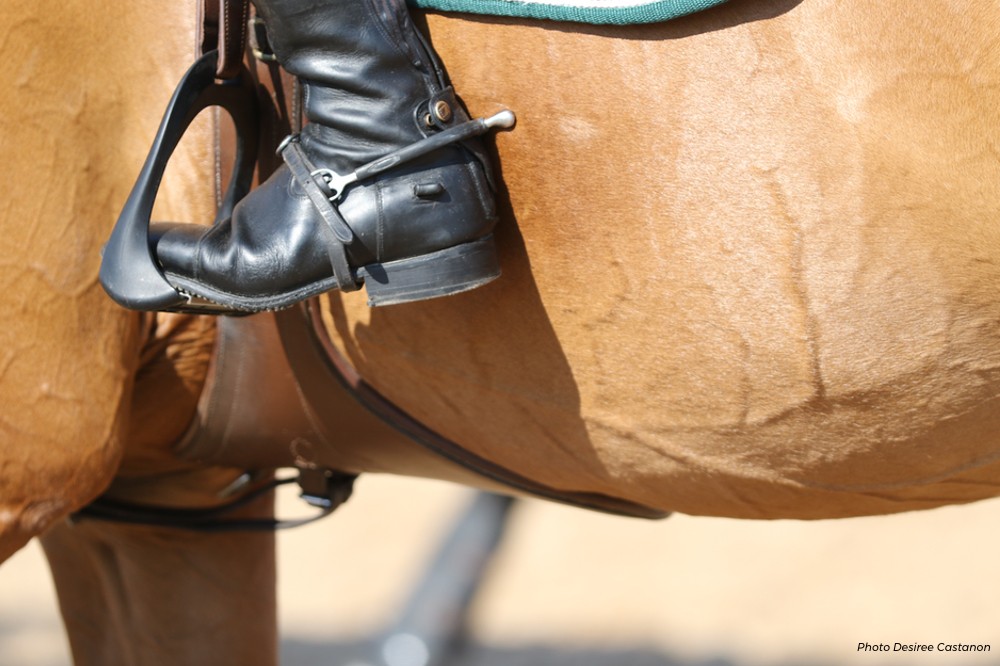The Blood Rule: Could the FEI Ease Restrictions?

The sharply contested blood rule, as it stands today and is enforced by the FEI in show jumping, is about to be open for review.
The FEI has shared documents related to rule changes and clarifications for the sport of show jumping, which assembly members will discuss and vote upon at the FEI General Assembly on Nov. 18-21. This is the first year in FEI history that the international governing organization of Olympic equestrian sports has made working documents related to rule changes available for public viewing.
These documents offer a glimpse into what national federations and rider advocacy organizations think about the rules and how they affect the show jumping riders they represent. Each group was allowed to comment on the proposed changes, make recommendations and share their positions. Not everyone is invited to the General Assembly — only representatives from these various national federations, as well as stakeholders who have the opportunity to vote. The General Assembly will be broadcast live this year for viewing.
Here are the FEI’s initial proposals and some of the comments from various associations and federations about the proposed changes to the blood rule in show jumping.
What’s up for consideration:
- Proposed change: “3.30 blood on the Horse’s flank(s) caused by the Athlete’s leg. NB: Minor cases of blood on the flank(s) as described in the Jumping Stewards Manual do not incur elimination.”
Federation reaction:
Spanish Equestrian Federation: “This rule, by definition, will be a judgement call. This situation will lead to many different possible problems because there is no clear guideline. What is a minor case of blood on the flank? How those cases are going to be identified? Where is the border line between a minor and a major case? In our opinion, this rule SHOULD STAY AS IT IS NOW.”
Israel Equestrian Federation: “It’s very unlikely that the athlete’s leg could cause blood to be shed. Do you mean the athlete’s boot or his spur? Proposed wording: blood on the Horse’s flank(s) caused by the Athlete’s boot/spur. NB: Minor cases of blood on the flank(s) as described in the Jumping Stewards Manual will not incur elimination.”
International Jumping Officials Club: “Decisions taken by Officials must be objective, comprehensible, follow clear principles and be applied uniformly worldwide. Rules that determine whether or not an athlete is disqualified/eliminated or wins a competition – the two extremes of possible outcomes – must not be left open to interpretation or subjectivity. The IJOC represents FEI Jumping Officials from over 50 nations, and all of the feedback we have received on the proposed changes to the rule have expressed doubt and concern over how it would work in practice and the liability that we would be exposed to. While, in principle, we understand the reasons behind the proposal for changes to the sanction, we are extremely reluctant to accept changes to the catalyst of the sanction. Under the current rule and even in the clearest cases, the decision to disqualify an athlete is often hotly – not to mention publicly – contested. The proposed introduction of Art 241.3.30 and the change to the wording of Art 242.3.1 open the door for the athlete and his/her entourage to legitimately challenge any decision to eliminate or disqualify not only in situ and within the FEI legal system, but also to bring civil law suits against the officials who have taken those decisions. We therefore kindly ask the Jumping Committee to reconsider the current proposals for changes to Art. 231.3.30 & 242.3.1.”
- Proposed Change: “Disqualification is mandatory in the following cases: 3.1 Horses bleeding, Marks and/or blood on the flank(s) as a result of excessive use of spurs; 3.2 Marks and/or blood anywhere on the Horse indicating as a result of excessive use of spurs or of the whip anywhere on the Horse.”
Federation reaction:
German Equestrian Federation: “Any decision taken by an Official must be comprehensible and follow precise guidelines, he or she cannot be left alone with it and we cannot vote for a wishy-washy rule. It has to be clear that Athletes must be eliminated whenever there is blood. That way the results of the performance delivered up to then are acknowledged. A disqualification should be made in serious cases of abuse. Horse welfare and horsemanship must have utmost priority. We are responsible for the horse, no horse may be harmed and if it happens, we must act. We must not forget that we must explain ourselves to the public. This topic is a very emotional one and we are at risk to discredit horse sport’s reputation. Some examples of comments received from the equestrian community: “profit prevails animal welfare”, “it is all about the riders’ greed no matter if the horse is doing well”, “a horse is not a piece of sports equipment”, “this would be a step back in horse welfare”, “horse sport is stuck somewhere in the 19th century”, “FEI loses its credibility – no wonder laymen think all of us riders are animal torturers”, “we may not look away”.”
Netherlands Equestrian Federation: “We believe that for the public opinion it would be better to use a friendlier word/description for “blood”, as we use “banned medication” instead of “doping”. We also believe that, despite the discipline-specific differences the “blood rule” should be equal for all disciplines and therefore needs to be included in the GRs. Practical issues can be placed in discipline rules. To ensure that stewards and judges are able to make comprehensible and consistent decisions we recommend involving an FEI veterinarian in the procedure when checking the horses. Art. 241.3.30: What are the criteria for a “minor” case of blood.”
Sweden Equestrian Federation: “Horse welfare must have utmost priority! We are responsible for the horse. The general public are becoming increasingly intolerant of anything that can be considered animal abuse. We think that it’s too difficult for an Official not to have precise guidelines to follow regarding minor cases of blood. We support the new wording of elimination instead of disqualification whenever there is blood on the Horse’s flank. A disqualification should be made in serious cases of abuse as described in Art. 242.”
International Jumping Riders Club: “The IJRC asks the FEI to introduce a yellow card, effective for 1 or 2 months, only at the second time there should be a disqualification. Consider that a veterinary should be part of the decision. Find a clear proceeding, a clear protocol. Change the name of the rule, (i.e. “spurs rule”)”
U.S. Equestrian Federation: “The U.S. is very much in favor with the distinction between elimination and disqualification in the cases where blood is found on a horse’s flank(s). This distinguishes between the intentional and unintentional and is a welcome addition to the rules. However, there is some concern with the language in 241.3.20 “……N.B. Minor cases of blood on the flank(s) as described in the Jumping Stewards Manual do not incur elimination.” Although we support the language as written, we hope that the FEI provides enough guidance to the officials so there can be a uniform approach as to how an official determines whether a case is “minor.” There is concern that it will vary from Official to Official and that it may not be a level playing field or will cause antagonist disagreement between athletes and FEI Officials.”
Background on the Blood Rule:
It’s important to note that the way the laws related to blood on a horse stand now vary between show jumping, dressage, eventing and hunter disciplines. But the the intention is the same: to safeguard the welfare of the horse. For a long time, top riders and trainers have been at odd ends on how the rule should be enforced. One camp believes each incident should be dealt with on a case-by-case basis. Others say there’s no room for tolerance in any sense.
Meanwhile, some top riders have been eliminated from competitions, like show jumping at the Olympic Games in Rio or Grand Prix level dressage at the World Equestrian Games, because of the blood rule.
If a rider is eliminated from competition because of blood on the horse, they can appeal the decision to FEI officials.
Here’s the rule language as it stands now [broken down by discipline]:
Dressage: [FEI Article 430] If a judge or FEI steward suspects fresh blood anywhere on the horse before, during or after a test, they can stop the horse to check for blood. If the horse shows fresh blood anywhere on the body, it will be eliminated. If no fresh blood is found, the horse and rider can resume or ride the test without penalty. If blood is found after a test is completed, the horse and rider could still be eliminated by the judge. A veterinarian will determine if the horse can continue competing. If a horse is disqualified for blood during the Grand Prix test at the Olympic Games and is competing as an individual, it will not be eligible to go through the Grand Prix Special, even if a veterinarian determines the horse is fit to continue. If competing on a team, the veterinarian can determine the horse is clear to continue.
Eventing: [FEI Article 526.4] Blood on horses may be an indication of abuse of the horse and must be reviewed case-by-case by the ground jury. In minor cases of blood in the mouth, such as where a horse appears to have bitten its tongue or lip, or minor bleeding on limbs, the ground jury may investigate and authorize the athlete to continue.
Show Jumping: [FEI Article 242.3.1] Officials may eliminate a rider and horse pair if a horse is bleeding on the flank(s), in the mouth or nose, or has marks indicating excessive use of spurs or of the whip anywhere on the body. Officials may authorize the rinsing or wiping of the mouth and allow the horse to continue but any further evidence of blood will result in disqualification.
Hunter/Jumper: There is no national rule by the USEF or USHJA that enforces blood on a horse, said Mary Babick, president of the USHJA. However, general welfare rules say a judge or a steward may disqualify a rider and horse pair if they see blood on the animal. It is judged on a case-by-case basis.


